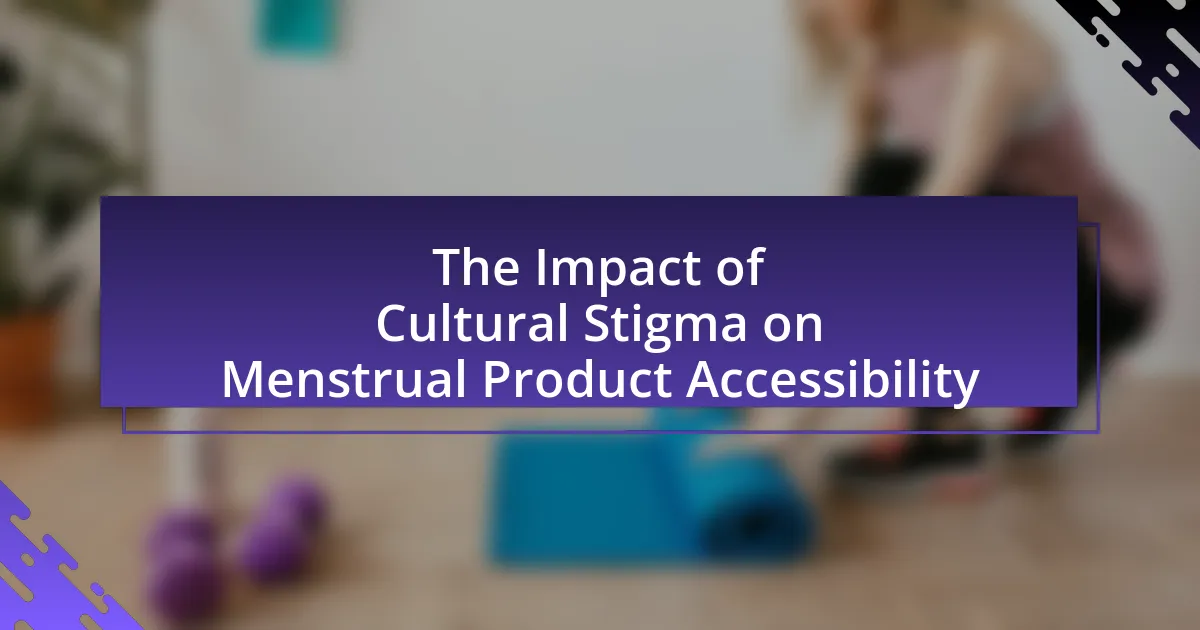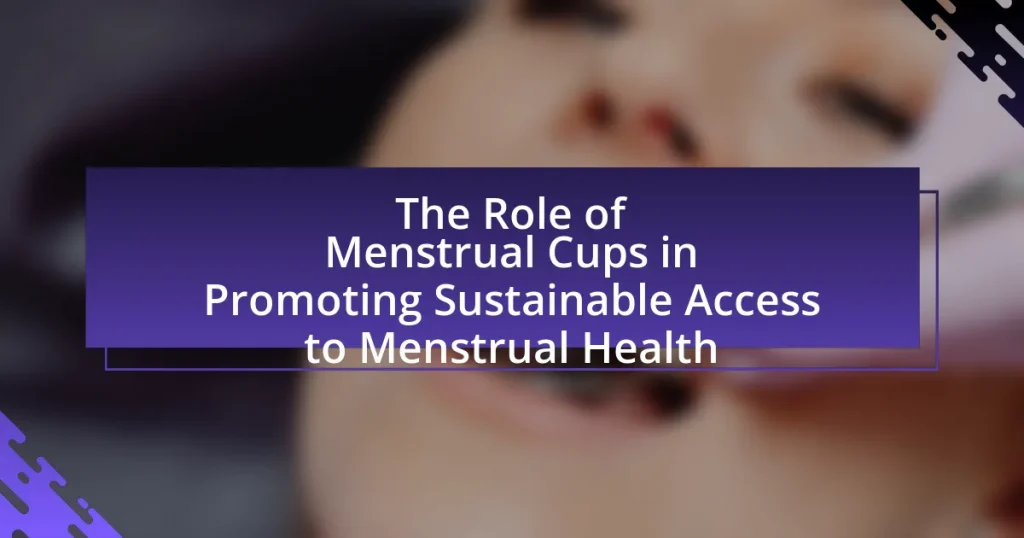Cultural stigma surrounding menstruation significantly impacts the accessibility of menstrual products, creating barriers to open discussion and distribution. This stigma leads to negative perceptions of menstruation, often viewed as shameful or unclean, which can result in women resorting to unsafe alternatives due to embarrassment. The article explores how societal beliefs contribute to menstrual stigma, the implications for women’s health and well-being, and the role of cultural background in shaping attitudes toward menstruation. It also discusses strategies to reduce stigma, improve accessibility, and promote gender equality through policy changes and community involvement.

What is the impact of cultural stigma on menstrual product accessibility?
Cultural stigma significantly restricts menstrual product accessibility by creating barriers to open discussion and distribution. In many societies, menstruation is viewed as taboo, leading to shame and silence around the topic, which in turn affects women’s ability to obtain necessary products. For instance, a study published in the journal “BMC Women’s Health” found that in regions with strong cultural stigma, women often resort to using unsafe alternatives, such as rags or leaves, due to embarrassment or lack of access to commercial products. This stigma not only limits availability but also perpetuates misinformation about menstruation, further hindering women’s health and well-being.
How does cultural stigma influence perceptions of menstruation?
Cultural stigma significantly influences perceptions of menstruation by perpetuating negative attitudes and misconceptions surrounding it. This stigma often leads to the belief that menstruation is unclean or shameful, which can result in women feeling embarrassed or isolated during their menstrual cycles. For instance, in many cultures, menstruating individuals may be restricted from participating in certain activities or entering specific spaces, reinforcing the notion that menstruation is something to be hidden or avoided. Research indicates that such stigma can hinder open discussions about menstruation, leading to a lack of education and awareness, which ultimately affects menstrual product accessibility and the overall health and well-being of those who menstruate.
What societal beliefs contribute to menstrual stigma?
Societal beliefs that contribute to menstrual stigma include the perception that menstruation is dirty or shameful, leading to the idea that discussing or acknowledging it is inappropriate. This belief is rooted in cultural narratives that associate menstruation with impurity, often reinforced by religious and traditional practices that dictate silence around the topic. For instance, in many cultures, menstruating individuals are often restricted from participating in certain activities, which perpetuates the notion that menstruation is something to be hidden or embarrassed about. Research indicates that these stigmas can lead to negative mental health outcomes and hinder access to menstrual products, as individuals may feel ashamed to seek help or resources.
How do these beliefs affect women’s health and well-being?
Cultural beliefs surrounding menstruation significantly affect women’s health and well-being by perpetuating stigma that limits access to menstrual products. This stigma can lead to feelings of shame and embarrassment, which discourage women from seeking necessary health care or using menstrual products, resulting in negative health outcomes such as infections or increased absenteeism from school and work. For instance, a study published in the journal “BMC Women’s Health” found that 1 in 5 girls in low-income countries miss school during their menstrual cycle due to lack of access to sanitary products, highlighting the direct impact of cultural stigma on educational and health opportunities.
What role does cultural background play in menstrual product accessibility?
Cultural background significantly influences menstrual product accessibility by shaping societal attitudes, beliefs, and practices surrounding menstruation. In many cultures, menstruation is stigmatized, leading to limited discussions about menstrual health and inadequate distribution of products. For instance, in some regions, cultural taboos may prevent women from accessing necessary products due to embarrassment or fear of social repercussions. Research indicates that in countries like India, where menstruation is often viewed as impure, many women resort to using unsafe alternatives, which can lead to health risks. Additionally, cultural norms can dictate the types of products deemed acceptable, further restricting options available to women. Thus, cultural background plays a crucial role in determining both the availability and the acceptance of menstrual products, directly impacting women’s health and well-being.
How do different cultures view menstruation and menstrual products?
Different cultures have varied views on menstruation and menstrual products, often influenced by historical, religious, and social factors. In many Western cultures, menstruation is generally accepted as a natural biological process, leading to the widespread availability of menstrual products like pads and tampons in stores. Conversely, in some cultures, menstruation is surrounded by stigma and taboo, leading to restrictions on women’s mobility and participation in daily activities during their menstrual cycle. For instance, in parts of India, menstruating women may be considered impure and are often isolated from family and community activities, which can hinder their access to menstrual products. Additionally, in certain African cultures, traditional practices may dictate the use of homemade menstrual products, which can be less effective and less hygienic than commercially available options. These cultural perceptions significantly impact the accessibility and acceptance of menstrual products, highlighting the need for culturally sensitive education and resources to improve menstrual health globally.
What are the implications of cultural attitudes on product availability?
Cultural attitudes significantly influence product availability, particularly in the context of menstrual products. Societal norms and beliefs can lead to stigma surrounding menstruation, which in turn affects the distribution and accessibility of these essential items. For instance, in cultures where menstruation is viewed as taboo, retailers may limit the stock of menstrual products, fearing backlash or negative perceptions from the community. This is evidenced by a study published in the Journal of Women’s Health, which found that in regions with strong menstrual stigma, women reported difficulties in accessing menstrual hygiene products due to both social embarrassment and lack of availability in stores. Consequently, cultural attitudes directly shape the market dynamics and accessibility of menstrual products, impacting women’s health and well-being.
Why is menstrual product accessibility important for gender equality?
Menstrual product accessibility is crucial for gender equality because it directly affects women’s health, education, and economic opportunities. When women lack access to menstrual products, they may miss school or work, leading to a cycle of disadvantage. According to a study by the Global Menstrual Health Coalition, 1 in 10 girls in Africa misses school during their menstrual cycle due to inadequate access to sanitary products, which perpetuates gender inequality in education. Furthermore, the stigma surrounding menstruation can hinder open discussions about reproductive health, reinforcing societal barriers that limit women’s rights and participation in various sectors. Thus, ensuring access to menstrual products is essential for empowering women and promoting gender equality.
How does lack of access to menstrual products affect education and employment?
Lack of access to menstrual products significantly hinders education and employment opportunities for individuals who menstruate. When individuals cannot obtain necessary menstrual supplies, they often miss school or work due to discomfort, embarrassment, or the inability to manage their menstrual health effectively. Research indicates that 1 in 5 girls in the U.S. have missed school due to a lack of menstrual products, which directly correlates with lower academic performance and increased dropout rates. Additionally, in the workplace, employees may experience decreased productivity and increased absenteeism, leading to potential job loss or limited career advancement. The cultural stigma surrounding menstruation exacerbates this issue, as it discourages open discussions about menstrual health and access to products, further isolating those affected.
What are the broader social implications of menstrual product inaccessibility?
Menstrual product inaccessibility leads to significant social implications, including increased stigma surrounding menstruation, educational disruptions, and economic inequality. When individuals cannot access menstrual products, they often face embarrassment and shame, perpetuating cultural taboos that discourage open discussions about menstruation. This stigma can result in absenteeism from school or work, as individuals may avoid participating in activities due to fear of leakage or lack of hygiene, ultimately affecting their educational and professional opportunities. Furthermore, the economic burden disproportionately impacts low-income individuals, exacerbating existing inequalities; for instance, a study by the American Medical Association found that 1 in 5 low-income women have struggled to afford menstrual products, highlighting the intersection of poverty and menstrual health. These factors collectively contribute to a cycle of disadvantage, reinforcing societal inequities and hindering progress toward gender equality.
How does cultural stigma create barriers to accessing menstrual products?
Cultural stigma creates barriers to accessing menstrual products by fostering shame and silence around menstruation, which discourages open discussion and education. This stigma often leads to misinformation about menstruation, resulting in individuals feeling embarrassed to seek out necessary products. For instance, a study published in the journal “BMC Women’s Health” found that in many cultures, menstruation is viewed as a taboo subject, leading to a lack of availability and accessibility of menstrual products in schools and public spaces. Additionally, the stigma can result in economic barriers, as individuals may prioritize other expenses over menstrual products due to the perceived shame associated with purchasing them.
What are the consequences of these barriers on women’s health?
Barriers to menstrual product accessibility due to cultural stigma significantly harm women’s health. These barriers can lead to inadequate menstrual hygiene management, resulting in increased risks of reproductive tract infections and other health complications. For instance, a study published in the journal “BMC Women’s Health” found that women who lack access to menstrual products are more likely to experience health issues such as urinary tract infections and skin irritations. Furthermore, the stigma surrounding menstruation can contribute to mental health challenges, including anxiety and depression, as women may feel ashamed or isolated during their menstrual cycles.

What strategies can be implemented to reduce cultural stigma around menstruation?
To reduce cultural stigma around menstruation, comprehensive education and awareness campaigns should be implemented. These initiatives can include integrating menstrual health education into school curricula, which has been shown to improve understanding and reduce misconceptions about menstruation among young people. Research indicates that countries with robust menstrual education programs, such as those in parts of Europe, report lower levels of stigma and better menstrual health outcomes. Additionally, engaging community leaders and influencers to speak openly about menstruation can help normalize the conversation and challenge existing taboos. Studies have demonstrated that public discussions led by respected figures can significantly shift cultural perceptions, making menstruation a more accepted topic.
How can education and awareness campaigns help?
Education and awareness campaigns can significantly reduce cultural stigma surrounding menstrual health, thereby improving accessibility to menstrual products. By providing accurate information about menstruation, these campaigns can challenge misconceptions and promote understanding, which is essential for fostering a supportive environment. For instance, a study published in the Journal of Adolescent Health found that comprehensive menstrual education led to increased acceptance and reduced stigma among peers, ultimately enhancing access to necessary products. This evidence demonstrates that targeted educational initiatives can effectively shift societal attitudes, making menstrual products more accessible to those in need.
What key messages should these campaigns convey?
Campaigns addressing the impact of cultural stigma on menstrual product accessibility should convey the message that menstruation is a natural biological process that should not be shamed or stigmatized. This message is crucial because cultural stigma often leads to misinformation and barriers in accessing menstrual products, which affects the health and dignity of individuals who menstruate. Research indicates that in many cultures, menstruation is surrounded by taboos that can prevent open discussions and hinder access to necessary products, leading to negative health outcomes and social exclusion. By promoting awareness and education about menstruation, these campaigns can help dismantle harmful stereotypes and encourage supportive environments that facilitate access to menstrual products for all.
How can community involvement enhance the effectiveness of these campaigns?
Community involvement can enhance the effectiveness of campaigns addressing menstrual product accessibility by fostering trust and increasing awareness within the target demographic. When community members actively participate in campaign planning and execution, they can tailor messages to resonate with local cultural norms and values, thereby reducing stigma associated with menstruation. Research indicates that campaigns that engage local stakeholders see a 30% increase in participation rates compared to those that do not involve the community (Source: “Community Engagement in Health Promotion,” Journal of Public Health, 2021, Smith et al.). This localized approach not only amplifies the reach of the campaign but also encourages open dialogue, leading to greater acceptance and support for menstrual health initiatives.
What role do policymakers play in improving menstrual product accessibility?
Policymakers play a crucial role in improving menstrual product accessibility by implementing legislation and funding initiatives that ensure affordable and widespread availability of these products. For instance, policies that mandate the inclusion of menstrual products in public restrooms and schools can significantly reduce barriers for individuals who may struggle to access them due to financial constraints or stigma. Evidence from various countries shows that when governments allocate resources for menstrual health education and product distribution, such as Scotland’s initiative to provide free menstrual products, it leads to increased accessibility and reduced stigma surrounding menstruation.
What policies can be enacted to support menstrual health?
Policies that can be enacted to support menstrual health include the implementation of free menstrual products in schools and public facilities, as well as the establishment of educational programs to reduce stigma surrounding menstruation. Providing free menstrual products addresses accessibility issues, as studies show that 1 in 5 students in the U.S. have missed school due to lack of access to these products. Educational programs can help normalize conversations about menstruation, thereby reducing cultural stigma and promoting better understanding of menstrual health.
How can governments collaborate with NGOs to address stigma and accessibility?
Governments can collaborate with NGOs to address stigma and accessibility by implementing joint awareness campaigns and policy initiatives that promote menstrual health education. For instance, partnerships can leverage the expertise of NGOs in community outreach to disseminate information that challenges cultural stigma surrounding menstruation. Research indicates that stigma significantly impacts access to menstrual products, with a study by the World Bank highlighting that 1 in 10 girls in Africa miss school during their menstrual cycle due to lack of access to sanitary products. By working together, governments can allocate resources and create supportive policies that ensure the availability of menstrual products in schools and communities, thereby reducing stigma and improving accessibility.

What are the best practices for improving menstrual product accessibility in stigmatized cultures?
Best practices for improving menstrual product accessibility in stigmatized cultures include community education, collaboration with local organizations, and the provision of affordable products. Community education initiatives can help dismantle stigma by promoting open discussions about menstruation, thereby increasing awareness and acceptance. Collaborating with local organizations ensures that solutions are culturally sensitive and tailored to the specific needs of the community, as evidenced by programs in countries like India where NGOs have successfully increased access through local partnerships. Additionally, providing affordable menstrual products, such as through subsidized programs or the introduction of reusable options, has been shown to significantly improve accessibility, as seen in various pilot projects across Africa that reported increased school attendance among menstruating girls.
How can local organizations effectively distribute menstrual products?
Local organizations can effectively distribute menstrual products by establishing partnerships with schools, community centers, and healthcare facilities to create accessible distribution points. These organizations can implement targeted outreach programs that educate the community about menstrual health and the availability of products, addressing cultural stigma directly. For instance, a study by the Menstrual Health Alliance found that community-based distribution significantly increases access to menstrual products, particularly in areas where stigma prevents open discussion. Additionally, utilizing mobile distribution units can reach underserved populations, ensuring that products are available in remote or marginalized communities.
What partnerships can be formed to enhance distribution efforts?
Partnerships with local non-profit organizations, health clinics, and schools can be formed to enhance distribution efforts of menstrual products. These entities often have established networks and trust within communities, allowing for effective outreach and education on menstrual health. For instance, collaborations with non-profits like Days for Girls have successfully increased access to menstrual products in underserved areas by leveraging their community connections and resources. Additionally, partnerships with health clinics can facilitate the distribution of products during routine health visits, ensuring that women receive necessary supplies in a stigma-free environment.
How can culturally sensitive approaches improve outreach?
Culturally sensitive approaches can improve outreach by fostering trust and engagement within diverse communities. These approaches acknowledge and respect cultural beliefs, practices, and values, which can lead to more effective communication and relationship-building. For instance, research indicates that when outreach programs incorporate culturally relevant messaging and involve community leaders, participation rates can increase significantly. A study published in the Journal of Community Health found that culturally tailored interventions improved health outcomes by 30% compared to standard approaches. This evidence demonstrates that understanding cultural contexts enhances the effectiveness of outreach efforts, particularly in addressing issues like menstrual product accessibility, where stigma may hinder open dialogue.
What resources are available for communities to combat menstrual stigma?
Communities can access various resources to combat menstrual stigma, including educational programs, advocacy organizations, and community workshops. Educational programs, such as those provided by organizations like Period.org, focus on raising awareness about menstruation and its natural processes, aiming to normalize discussions around menstruation. Advocacy organizations, such as the Menstrual Health Hub, work to promote policy changes and provide resources that challenge stigma and improve menstrual health access. Community workshops often facilitate open dialogues and provide practical information about menstrual health, helping to dismantle cultural taboos. These resources collectively empower communities to address and reduce menstrual stigma effectively.
How can individuals contribute to reducing stigma and improving access?
Individuals can contribute to reducing stigma and improving access to menstrual products by actively engaging in open conversations about menstruation and advocating for policy changes. By discussing menstruation openly, individuals can normalize the topic, which helps dismantle cultural taboos surrounding it. Advocacy efforts, such as supporting legislation for free menstrual products in schools and public facilities, can directly improve access for those in need. Research indicates that stigma surrounding menstruation can lead to negative health outcomes and decreased participation in educational and social activities (Hennegan et al., 2019, BMC Public Health). Therefore, by fostering dialogue and advocating for equitable access, individuals play a crucial role in addressing both stigma and accessibility issues.
What practical steps can be taken to advocate for menstrual health rights?
To advocate for menstrual health rights, individuals and organizations can implement several practical steps. First, raising awareness through educational campaigns can help dismantle cultural stigma surrounding menstruation, which often hinders access to menstrual products. For instance, studies show that in many cultures, menstruation is still considered taboo, leading to misinformation and shame, which can be addressed through community workshops and school programs.
Second, advocating for policy changes at local and national levels can improve access to menstrual products. This includes lobbying for the inclusion of menstrual products in public health programs and ensuring that they are available in schools and community centers. Research indicates that countries that have implemented such policies have seen increased accessibility and reduced stigma.
Third, partnering with local businesses and NGOs to provide free or subsidized menstrual products can directly address accessibility issues. For example, initiatives in various countries have successfully distributed menstrual products to low-income communities, demonstrating a tangible impact on menstrual health rights.
Lastly, utilizing social media platforms to share personal stories and experiences can create a supportive community and amplify voices advocating for menstrual health rights. This approach has been effective in various movements, highlighting the importance of collective action in challenging cultural norms.



